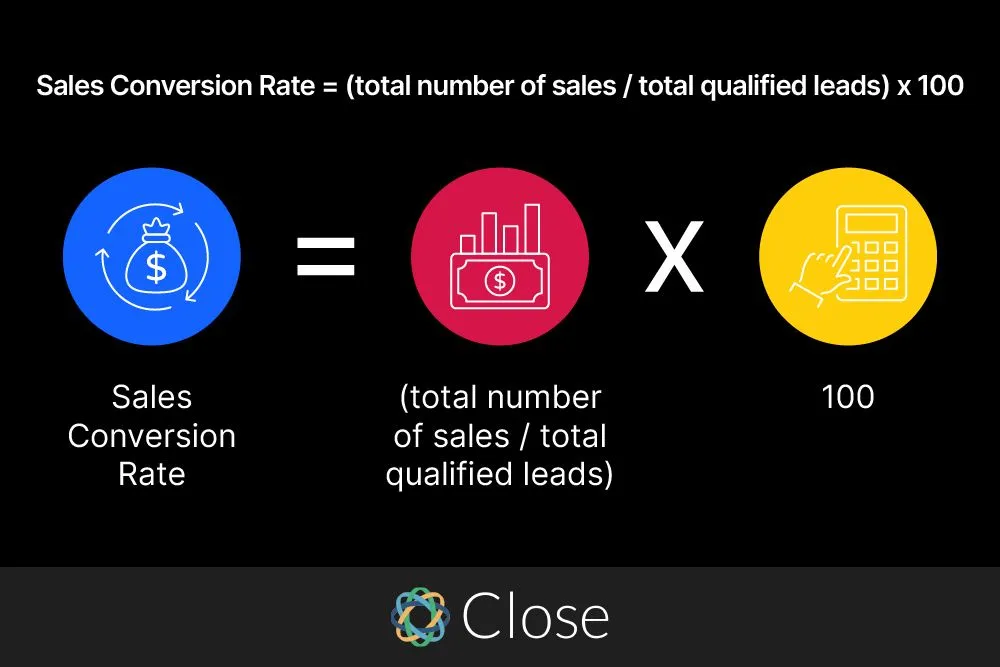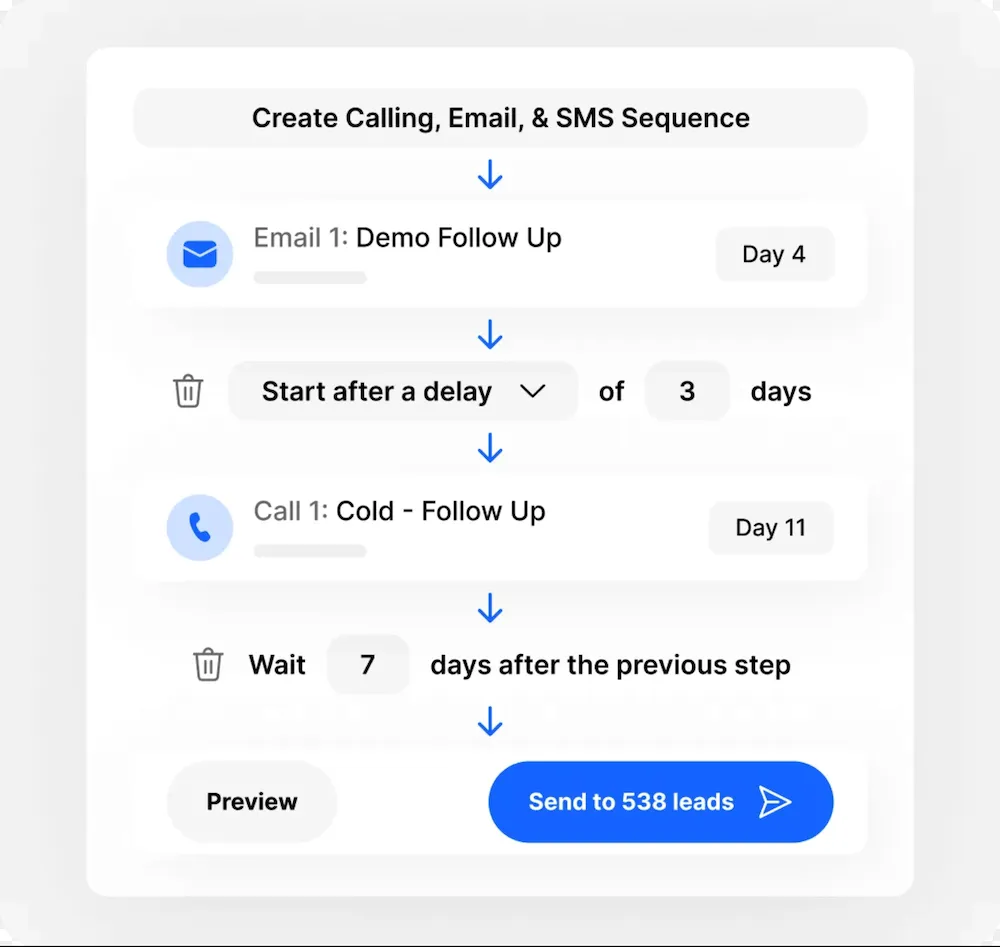
In the world of business, there’s one thing everyone wants: more sales. I’ve yet to hear someone say "no" to winning a new customer. The issue? There are dozens of activities and metrics you can focus on to generate more revenue.
But if you’re part of a sales team—or you manage one—you can’t influence that many metrics if you want to close more details. For example, you don’t have control over the traffic your website receives or the free trial signups a marketing campaign generates for your SaaS product.
What you can focus on, and influence, is your sales conversion rate. Once you understand what it is, you can monitor how it changes over time and use specific strategies to grow it—and as a result, grow your revenue.
Ready? Here’s all you need to know about your sales conversion rate and what it takes to improve it.
Account-based sales can yield higher conversion rates and significant revenue growth.
What Is a Sales Conversion Rate?
It’s a straightforward way to track the performance of your sales team. That’s because the only numbers you’re focusing on when calculating your sales conversion rate are leads that enter the funnel, rather than your overall website traffic (which would be your website conversion rate!)
How to Calculate Your Sales Conversion Rate (Formula)
The sales conversion rate is calculated by dividing the total number of sales (a.k.a. the number of conversions) by the total number of qualified leads, multiplied by 100. The sales conversion formula is as follows:
 |
Here’s what this looks like with sample data for one month:
Total number of sales = 240
Total qualified leads = 1330
4 Steps for a More Accurate Sales Conversion Rate
Sales conversion rate might seem straightforward, but its actually a bit nuanced. Here are four things to keep in mind when calculating conversion rates for your sales team.
Psst...you want to learn about the role of cross-functional collaboration in delivering exceptional total contract value? Our article explains it all.
1. Make Sure Your Math Is Correct
One of the most common pitfalls when working with the sales conversion rate metric is using unrelated figures when running the formula.
Let’s say you want to calculate your sales conversion rate for March, so you take the total number of sales you made in March and divide it by the total number of leads that entered your sales pipeline in that same month. That’s your sales conversion rate, right?
Not quite.
Instead of going with sales made in March / leads created in March x 100, the right way to calculate is leads created in March and converted into a sale / leads created in March x 100.
Simply put: ensure both sides of your division come from the same bucket. Of course, if your average sales cycle is long—say, three months—it only makes sense to report on your sales conversion rate for leads that entered your pipeline more than three months ago.
2. Consider All Lead Sources
The accuracy of your sales conversion rate hinges on counting all the leads you’ve worked with. For usual lead generation campaigns and content like retargeting campaigns or case studies, that’s not an issue.
But lead sources you use less often may slip through the cracks. Some examples are conference sponsorships and co-marketing campaigns—don’t forget to include these in your tally of the total number of leads and sales.
3. Look at Sales Conversion Rate Through Different Filters
Your sales conversion rate tells you about your overall sales performance, essential for effective sales performance management. But its magic is in filtering that number to understand which portions of your sales process contribute to your sales and revenue more than others.
To accurately assess the impact on revenue, consider using the revenue growth calculator to quantify these contributions effectively.
Try looking at your sales conversion rate for different:
- Sales reps
- Sales teams
- Geographies
- Campaign types
- Lead sources
- Products
- Customer segments
This approach will help you understand what’s behind those inevitable peaks or dips in sales.
 |
4. Your Sales Conversion Rate Informs the Bigger Picture
Leads don’t appear out of thin air. They’re a result of cold calling, paid ads, emailing efforts, and other sales and marketing campaigns.
Use your sales conversion rate to guide regular check-ins with other teams in your business. Go over questions like:
- What’s the connection between the company’s digital marketing strategies—SEO, PPC, landing pages, email marketing, social media, and more—and the quality of your leads?
- What’s the impact of design changes and user experience (UX) issues on the number and quality of leads that enter your sales funnel?
- How does pricing influence your sales conversations and how you can position your product against your competitors?
This keeps sales and the rest of the company aligned and focused on the same goals.
5 Strategies to Improve Your Sales Conversion Rates
Now, let's dig deep into five strategies and tweaks that will skyrocket your conversion rates. We're not just talking about the final conversion here; we're talking about optimizing every stage of the sales funnel to plug those pesky leaks and drive more sales:
1. Improve Your Lead Qualification Process
If poor fit leads somehow make their way through your funnel, it costs you and your business on a number of levels.
They’ll waste a bunch of your time on pointless conversations, pull you away from the best prospects, and can be expensive to report even if you can convert them. Winning them will lift your sales conversion rate on the surface, but it's ultimately a lose-lose scenario.
Focus on these components to make your lead qualification more successful:
- Your ideal customer profile and how well the lead matches it, including company size, stage, industry, location, ideal use case, and more
- The needs of the company, the department, and (most importantly) the individual, and whether your product matches them
- Their decision-making process and how well it matches your sales cycle
- Other vendors they’ve worked with or are considering, and the criteria they’re using to purchase
Sales folks at Close ask just two questions to decide if a lead is worth talking to: the size of their sales team and their current CRM.
It doesn’t have to be complicated. It just needs to be specific so you can be 100 percent sure you can help your lead. Check out our list of 38 qualifying questions for more inspiration.
Attention marketers! Want to convert more leads? Check out our article on MQL vs. SQL.
2. Use Automation to Qualify and Nurture Leads
Sales automation has come a long way and can support every stage in your sales process. Manual work like tracking each lead’s activities and sending emails? A computer can do that for you.
This lets you focus on activities where you’re irreplaceable: understanding and empathizing with a lead so you can have 1:1 conversations and guide them towards the best possible solution (a.k.a. close more sales).
Here’s how automation fits into that picture through the different stages a lead goes through:
- Awareness: Track actions your lead is taking, like content they consume and marketing emails they interact with
- Consideration: Send emails with relevant content like videos, podcasts, upcoming webinars etc.
- Decision: Show ads and send emails that focus on live demos, case studies, coupons, and other incentives
Don’t forget to wrap up each email with effective call-to-action (CTA) so your leads have an obvious next action—and you have a metric that helps you track your automation success. These CRM-ready email templates can help.
 |
3. Follow up on Hot Leads Faster
A hot lead is someone who has shown interest in your products and is ready for a trial or a demo. They’re not vaguely browsing and researching their options—they want a solution ASAP.
That’s what makes them valuable. You’re on their map and because they’ve let you know by asking for a free trial or a product demo, the ball is in your court. It’s an opportunity you shouldn’t waste by waiting around.
The key is to identify those leads quickly so you can start a conversation and set up a time to chat sooner rather than later. This is where a CRM can help.
First, define the criteria for a hot lead, for example:
- Signed up for a free trial
- Came from a specific ad
- Filled out a form on your website
Then, use a feature like Close’s Custom Fields and Custom Activities to track this criteria and give the hot lead your time and attention quickly.
4. Master the Skill of Handling Objections
“It’s too expensive.”
“We’re too busy right now.”
“I’ll think about it.”
Sales objections come in many shapes (45, we counted), and if you’re not prepared for as many of them as possible, they’ll single-handedly bury your sales conversion rate.
Handling objections has three parts: being prepared for what’s coming, listening to what the lead is saying, and demonstrating that you understand their concerns. At its core, the goal is to double down on resolving objections in real time.
 |
Here are some of the most game-changing tips when it comes to overcoming sales objections:
- Have an objection management document that lists the most common objection your sales team runs into and a short response for each of them
- Be prepared with specific testimonials or case studies that show your prospect real-life proof of your product changing the game for a company just like them
- Keep your response to a lead’s objections short and to the point; making it too long will feel "salesy" to your lead rather than empathetic
- Confirm you’ve addressed and satisfied the objection instead of just assuming
If you’re a sales manager, leveling up your team’s objection-handling skills is one of the most impactful paths to a higher conversion rate.
5. Brush up on Your Closing Techniques
Winning deals is great. So is losing them. The worst place is the in-between—the maybe zone—in which you haven’t yet closed the sale, but you haven’t lost it either, so it’s a comfortable place of delaying your ask and your lead’s final decision.
Yes, hearing a "no" will lower your sales conversion rate a bit. But so will a "maybe," so you’re better off chasing those yeses—in other words, going for the close with every lead.
Here are some closing questions you can use:
- “What are all the steps we have to take to help make this deal happen?”
- “Are there any obstacles that could prevent this deal from happening?”
- “When do you want to make a decision and begin implementing a solution?”
- "If I was able to throw in [incentive], would you consider committing today?"
- "If we could find a way to deal with [objection], would you be ready to make this deal happen next week?”
- “Taking everything into consideration, I think one of these two plans would work best for you. Would you like to go with [X] or [Y]?”
- "You mentioned needing a solution by [X date]. If you signed up by [Y date], I can guarantee we have enough time for training and implementation. How does that sound?"
- “Do you feel ready to move forward? I can send over the contract right now.”
Check out our guide to closing a sale, which brings you 12 closing techniques, seven more closing questions, and seven closing phrases to start using right away.
Final Thoughts on Improving Your Sales Conversion Rates
Your sales conversion rate is an important KPI you can use to benchmark your sales team’s success at any moment.
It comes down to how successfully you’re moving leads through your pipeline, starting from turning marketing qualified leads into those that are looking for a solution to purchase and all the way through to the close. That means it’s about working with the right leads to begin with, dropping the ones that aren’t a fit, and going all in on the close once you understand their needs.
Don't overlook the importance of this metric—it drives your bottom line and the success of your business.










